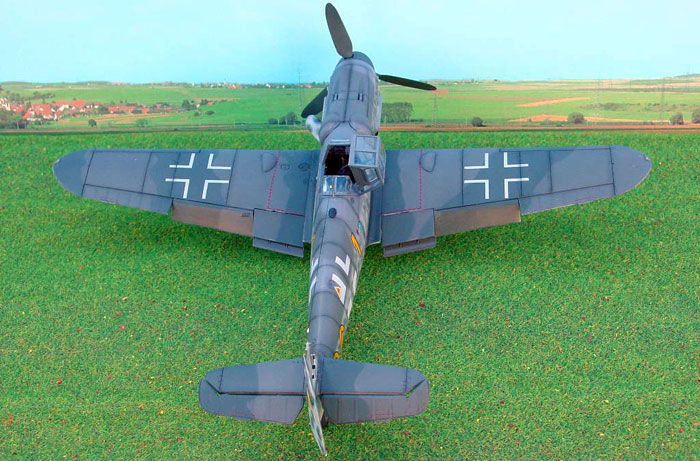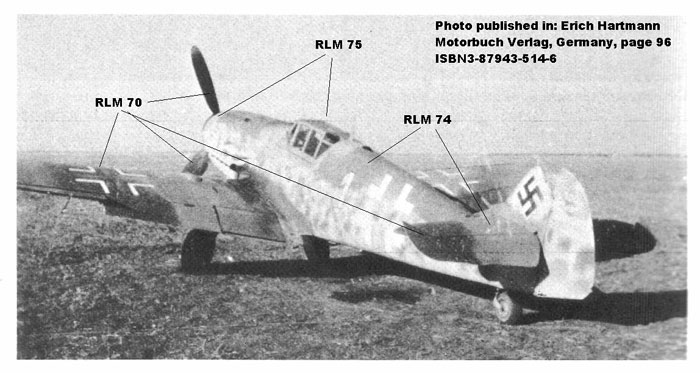|
Green
Fighters of the Eastern Front
JG 54 Colors in Russia
by
Michael Ullmann


HyperScale is proudly supported by Squadron.com
JG 54
"Dark" Camouflage Colors |
The actual colors of the dark camouflaged JG 54
aircraft on the Eastern Front remain a matter of controversy. In an
attempt to shine some light into this darkness I have written this
treatise.
The Facts
-
The
standardized camouflage for fighter aircraft during this period
was RLM 74/75/76. This lighter camouflage was optimized for
medium and high altitude fighter operations. It might be claimed
that this style of camouflage is still in use today as
"Air-Superiority" finishes on modern Combat Aircraft.
-
JG 54 was then
in action over a forest covered landscape in northern Russia.
-
The "dark"
camouflage of the JG 54 was a typical example of camouflage
altered at unit level to make the finish more appropriate to the
environment. Therefore no official orders would have been
issued.
-
Air combat on
the Eastern Front was typically undertaken at very low levels.
Only a very few encounters would have taken place at medium or
high level. The reason for this was that the absolute priority
of the Soviet air force (VVS) was to support the troops on the
ground.
-
Every Luftwaffe
unit had its own paint shop (surface protection and maintenance
group). Usually these people were very skilled and had years in
this trade
These are the facts. Now we head into
speculation! Even so, my assumptions are based on facts and
therefore I am sure that my hypothesis is not too far from the
truth.
The Mystery
Shortly after arriving in the area, JG 54
realized that the relatively light RLM 74/75/76 grey camouflage was
ineffective low on the deck over dark green Russian forests. When
the pilots of JG 54 quickly made this discovered, they very likely
went to their paint shop and ordered: "Paint my aircraft green!".
I am sure that many pilots remembered the early war RLM 70 Black
Green / RLM 71 Dark Green combination for fighters. Even at this
stage of the war, the green camouflage finish was still specified
for bombers and transports.
Every paint shop stocked extra paint for field camouflage and
markings. But a fighter unit paint shop does not stock green
camouflage paints. However, green camouflage paints were available
in the paint shops of Bomber or Transport units. In Russia it was
not unusual for different units to share one airfield or the next
airfield with bomber. Therefore I am sure that RLM 70 and 71 was
used for the JG 54 fighters.
Brown
Colours on JG 54 Fighters |
But what was with the brownish colors?
Color photos seem to show different shades from dark greenish brown
to a sandy brown. Some sources claim that these paints were captured
from the Soviets; or that this was the Desert color RLM 79; or that
the paint was an early ancestor of RLM 83. I would suggest that most
of these assertions are possible, except RLM 83, because it was
simply too early in 1943. RLM 83 appeared first in Autumn 1944.
Let us look at these options more closely:
Captured Soviet Paints
For the brown camouflage parts on a Fw 190,
roughly 10 kg paint would be needed. This means when you want to
paint 10 aircraft you must have 100 kg of captured paint, or an even
greater quantity if you would like to paint more. I can’t imagine
that the Soviets left such a large amount of usable goods for the
Germans! I have heard nothing from the use of captured Russian fuel,
food or paint.
German Desert Colors
Desert paints were, by definition, used in
North Africa. From northern Russia the nearest location to pick up
these paints was Germany. Every item had to be transported via ship,
train, truck and transportation aircraft to JG 54, and was very time
consuming. Can you imagine how long it would take to deliver paint
from Germany to JG 54 in northern Russia? It could need weeks, maybe
months!
The need to change camouflage would have been immediate, due to the
change of environment, and urgent to counter the disadvantage of the
light camouflaged aircrafts. There would have been no time to wait
for the ordered paints to arrive at unit level. Furthermore, I am
certain that other goods, like food or fuel, had a much higher
transportation priority than a can of paint
The Solution
So, what is the solution for this problem?
Elsewhere in this article I noted that that every unit had his own
paint shop; that the staff was very skilled; and that they stored
paints, including marking colors, like RLM 04 Yellow, RLM 23 Red,
RLM 24 Blue and RLM 25 Green.
Mixing RLM 23 Red and RLM 25 Green would result in a medium brown
color. Adding RLM 04 Yellow results in a sandy brown. Using RLM 70
instead of RLM 25 leads to a dark brownish green.
This seems to be the most likely explanation to me. The paint shop
mixed RLM marking paints to achieve the required colors. The
following points also work in favour of this argument:
-
RLM marking
paints were available immediately and in large amounts
-
RLM marking
paints would not effect the existing finish on the aircraft (the
impact of Soviet paints would have been unknown)
-
The paint shop
staff was skilled and had experience with the RLM marking colour
So, what was the pattern of the green
camouflage? No one knows this pattern, because no photo or
instructions exist. I am sure that every aircraft had a unique
pattern. Maybe the paint shop use the patterns of the grey
camouflage, but this is unknown.
The use of Russian or Desert camouflage paints by JG 54 was, in my
opinion, unlikely. Much more likely was the use of RLM 70 and 71
with self mixed colors over the existing RLM 74/75/76 grey
camouflage.
Still unanswered are the questions about the camouflage pattern and
the exact colors of the field mixed paints. These questions will
never be answered. I couldn't give an exact color. Therefore, we as
modelers must take the most likely scenario into account with a
liberal dose of artistic license.
Personally, I use the standard RLM 70/71 from my favorite model
paint brand. For the Brown and brownish dark Green I use whatever
usable color from my favorite model paint brand.
A Model Example
I have supplied a few photos of an exemplary
representation of camouflage altered at unit level.
I use one of my favorite models, a Hasegawa Bf-109 G-6, to show the
effects of altered camouflage. I built the kit as Erich Hartmann’s
Yellow “1” (see photo at top of page).
The aircraft’s camouflage was altered moderately, simply by
replacing the RLM 75 on the wings and stabilisators with RLM 70
Black Green. Compare the photo and you will see that the propeller
blades seem to be the same shade as the darker camouflage colour.
Therefore guessing the correct color was easy: every German metal
propeller blade was painted in RLM 70 as an anti-glare measure. Also
visible on the photo is that RLM 75 appearing very bright, peeking
through a hole in the camouflage.

Replacing RLM 75 with RLM 70 would result in a much more appropriate
darker finish.
I am sure that every one can imagine the effect of the bright
camouflage in comparison with the altered dark camouflage.
I hope that this discussion will help, and provide readers with some
food for thought and inspiration for modelling colour schemes!
Happy Modeling from Germany
Text & Images Copyright ©
2005 by Michael Ullmann
Page Created 01 March, 2005
Last Updated 01 March, 2005
Back to Reference Library
|
Home |
What's New |
Features |
Gallery |
Reviews |
Reference |
Forum |
Search